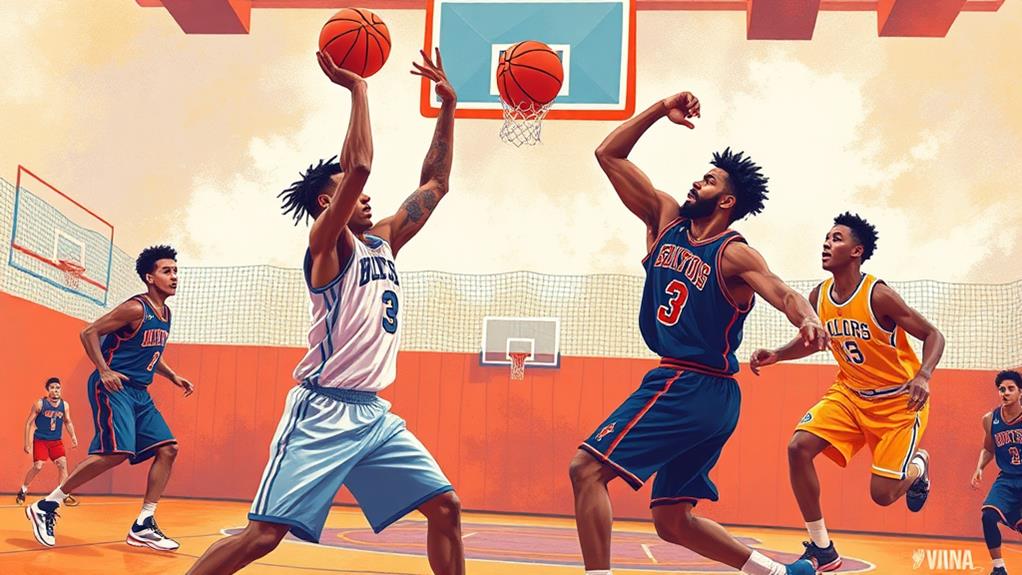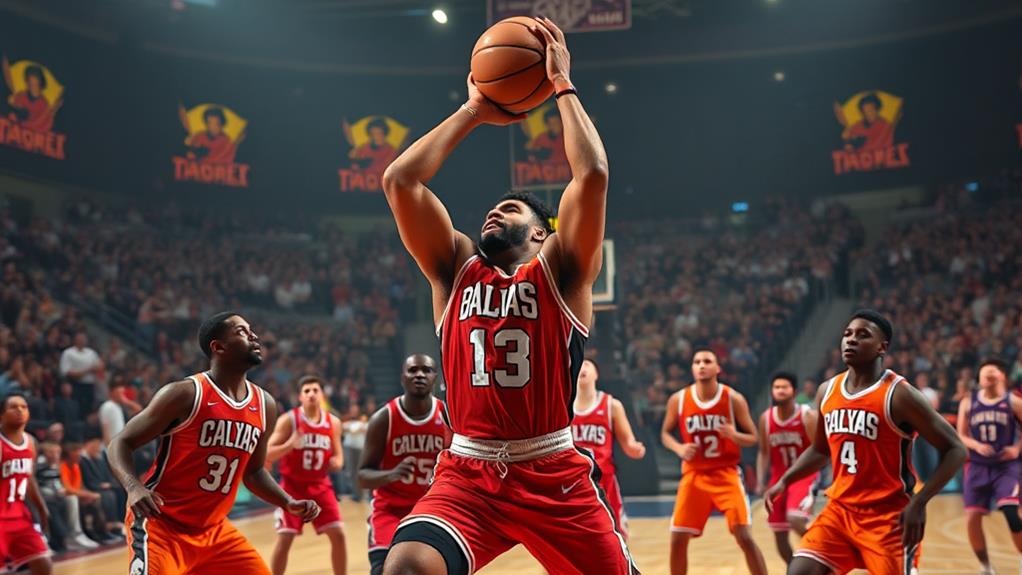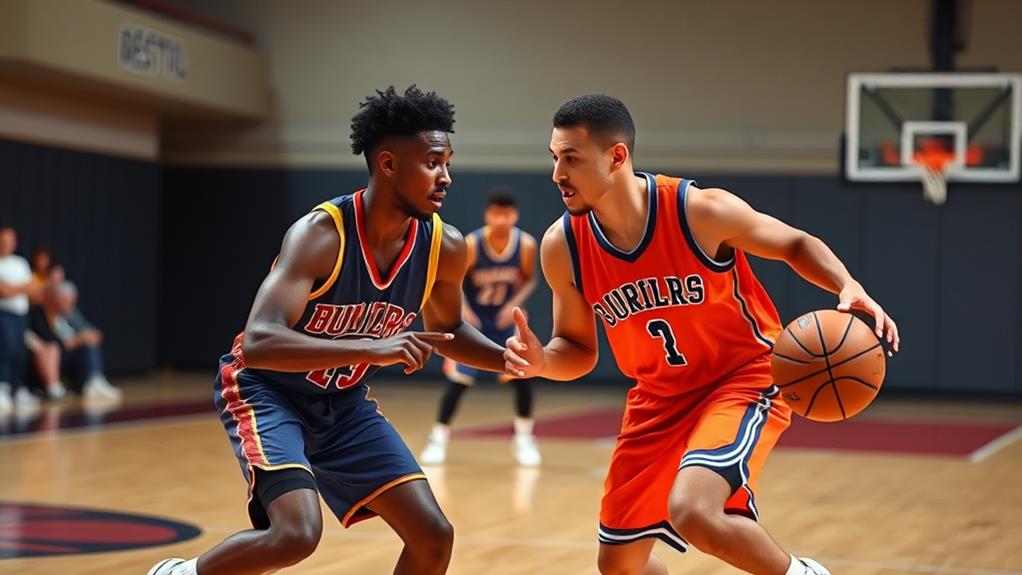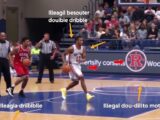
Understanding the Positions in Basketball: Roles and Responsibilities
November 8, 2024Understanding basketball positions helps you recognize each player's unique roles on the court. You've got five primary positions: point guard, shooting guard, small forward, power forward, and center. The point guard orchestrates the offense, while shooting guards excel in scoring. Small forwards are versatile, contributing to both defense and offense, and power forwards focus on scoring and rebounding. Centers dominate the paint, securing rebounds and blocking shots. Each role is essential for team dynamics, improving overall performance and strategy. If you want to discover how these roles work together, keep exploring the intricacies of basketball positions.
Overview of Basketball Positions
In basketball, each player fills a specific role that contributes to the team's overall strategy. The five primary positions—point guard, shooting guard, small forward, power forward, and center—each come with unique roles and responsibilities.
As the playmaker, the point guard often handles the ball and directs offensive plays. This position requires excellent ball handling and vision to create scoring opportunities, as well as an understanding of evolving defensive strategies that can impact playmaking.
The shooting guard typically excels in scoring, particularly with long-range shots, and also provides secondary support in ball handling.
The small forward serves as a versatile player, adapting to varying roles on the court and contributing considerably to both offensive and defensive efforts.
Meanwhile, power forwards focus on scoring near the basket and securing defensive rebounds. They often have a mix of size and agility to maneuver in the paint.
Center Position Responsibilities
As a center, you're vital for scoring near the basket, using your height to capitalize on offensive rebounds and close-range shots.
In addition to your scoring abilities, understanding the impact of team dynamics is essential, as it can influence your effectiveness on the court.
You also play a key role in rebounding and defense, blocking shots and securing boards to protect your team's chances.
Additionally, setting effective screens can create opportunities for your teammates, making your presence indispensable on the court.
Scoring Near the Basket
Scoring near the basket is where the center truly shines, leveraging their height and skills to dominate the paint. As the tallest player on the team, you focus on short-range shots, using effective post moves like drop steps and hooks to finish strong around the rim.
Positioning is essential; you need to establish a commanding presence in the low post area to receive passes and create scoring opportunities. Your role goes beyond just scoring; you draw defensive attention, often attracting double teams, which opens up opportunities for perimeter players.
When you're in the right spot, you can capitalize on offensive rebounds and putbacks, extending possessions and increasing your team's scoring chances. Rebounding is a key aspect of your responsibilities, as securing missed shots allows you to initiate offensive plays and maintain pressure on the opposing defense.
Rebounding and Defense
Rebounding and defense are the cornerstones of a center's role on the basketball court. As a center, your height and strength give you a significant advantage in securing both offensive and defensive rebounds.
You'll need a strong defensive mindset, as you'll often face off against other big players while also switching onto smaller opponents when necessary. Here are your key responsibilities:
- Blocking Shots: Utilize your size to deter opponents from attacking the rim. A well-timed block can change the momentum of the game.
- Securing Rebounds: Dominate the boards by grabbing both offensive and defensive rebounds, creating extra possessions for your team.
- Protecting the Rim: Your presence in the paint serves as a protective barrier, making it challenging for opponents to score close to the basket.
- Setting Screens: While we won't dive deep into this, remember that effective screens can create defensive mismatches, allowing teammates to exploit open shot opportunities.
Setting Screens Effectively
Setting effective screens is essential for a center to enhance offensive plays and create opportunities for teammates. As a center, your role in setting screens, especially during pick-and-roll situations, is imperative. You need to establish a solid and legal position before setting a screen, ensuring you avoid any offensive fouls while blocking defenders.
Timing is everything; your screen must coincide with the ball handler's movement. If you time it right, you maximize the chances of a successful play. Communication is important here. Make sure you signal to your teammates when you're about to set a screen so the ball handler is ready to use it effectively.
After setting the screen, don't just stand there—roll to the basket. This move can turn you into a significant scoring option, allowing you to utilize your size and strength to finish near the rim.
Power Forward Role Explanation

Have you ever wondered what makes the power forward position so essential to a basketball team? The power forward, or "four," typically stands between 6'7" and 7'0" and plays a significant role both offensively and defensively.
Modern power forwards are increasingly expected to stretch the floor with their shooting abilities, which aligns with the evolving dynamics of basketball where centers are essential in creating scoring opportunities.
Here are four key responsibilities of a power forward:
- Scoring: You're expected to contribute considerably to the team's scoring, using mid-range shots and three-point shots to stretch the floor.
- Rebounding: Your size helps you box out opponents and secure rebounds, making you a vital asset in controlling possession.
- Defensive Tasks: You'll often guard taller players in the post, needing to be physically strong while also quick on your feet.
- Versatility: Modern power forwards like Giannis Antetokounmpo and Dirk Nowitzki exemplify versatility, adapting to play inside and outside based on the team's offensive strategies.
In essence, being a power forward means blending scoring and rebounding skills while remaining adaptable defensively.
Your effectiveness in these areas can turn the tide of a game, solidifying your importance on the court.
Small Forward Versatility
Emphasizing adaptability, the small forward position stands out as one of the most versatile roles in basketball. As a small forward, you're expected to excel in scoring, rebounding, and defending, making you an essential asset on the court.
Typically ranging from 6'4" to 6'9", you can match up effectively against both guards and forwards, enhancing your ability to create mismatches. This versatility is akin to the dimensions and requirements of soccer, where players must be adaptable in their roles to succeed on the field.
Your scoring ability shines through as you can shoot from three-point range, hit mid-range jumpers, or drive to the basket, making you one of the key offensive threats on your team.
Additionally, small forwards often take on the responsibility of guarding the opposing team's best scorer, which requires strong defensive skills and agility to shut them down.
Notable small forwards in NBA history, like LeBron James and Larry Bird, have demonstrated this position's impact through a blend of scoring, playmaking, and defensive prowess.
Guard Positions Explained

In basketball, guards play a pivotal role in both offense and defense, often acting as the team's primary decision-makers on the court. Understanding the distinct roles of the point guard and shooting guard is essential for grasping their responsibilities.
Additionally, effective teamwork & communication are fundamental components in a guard's game, allowing them to create scoring opportunities and maintain the flow of the game.
- Point Guard: Typically the shortest player, you'll advance the ball, orchestrate the offense, and focus on assists, showcasing your ball-handling skills.
- Shooting Guard: As a scoring threat, you excel in long-range shooting, creating your own shots, and often serve as a secondary ball-handler.
- Defense: Both positions require strong defensive capabilities. The point guard defends the opposing ball-handler, while the shooting guard often guards the best perimeter player on the opposing team.
- Teamwork & Communication: Effective teamwork and communication are crucial as you work together to create scoring opportunities and maintain game flow.
Importance of Team Composition
A well-balanced team composition is essential for maximizing performance on the basketball court. You need a mix of positions—one point guard, one shooting guard, two forwards, and one center—to optimize both offensive and defensive strategies. Each position brings unique player skills: point guards excel in playmaking, shooting guards are your go-to scorers, small forwards offer versatility, power forwards blend strength and shooting, and centers control the paint.
Understanding how different positions work together enhances overall team dynamics, similar to how players showcase skills and teamwork in soccer on the field team collaboration in soccer.
Modern basketball thrives on hybrid positions like stretch fours and combo guards, allowing you to adapt to various defensive strategies and exploit mismatches. This flexibility can make your team more unpredictable and harder to defend against.
Moreover, an effective team composition enhances chemistry, as players in complementary roles support each other's strengths and weaknesses. This synergy is essential during gameplay, enabling seamless shifts between offensive and defensive strategies.
Ultimately, it's important to evaluate player skills when constructing your roster. Each position should be filled with athletes who can't only perform their specific roles effectively but also adapt to the dynamic situations that arise during a game.
This thoughtful approach to team composition can greatly elevate your team's performance.
Conclusion
Understanding basketball positions is like assembling a jigsaw puzzle; each piece has its unique shape and purpose, but together they create a complete picture. Just as a center anchors the defense, a guard ignites the offense, and every player contributes to the team's synergy. Think of the 2022 NBA champions, who showcased how diverse roles can harmonize for success. So, whether you're playing or watching, appreciate the intricate dance of roles that makes basketball a thrilling sport.


